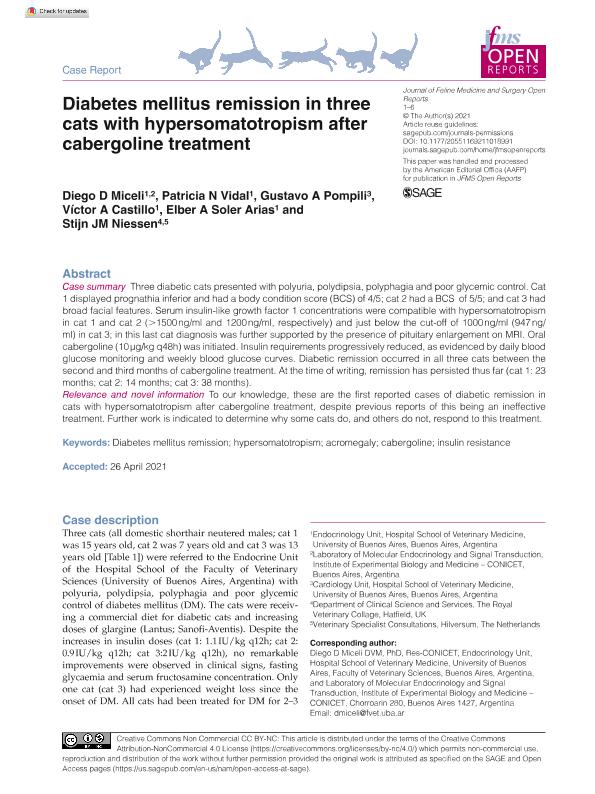Artículo
Diabetes mellitus remission in three cats with hypersomatotropism after cabergoline treatment
Miceli, Diego Daniel ; Vidal, Patricia Noemi
; Vidal, Patricia Noemi ; Pompili, Gustavo A; Castillo, Víctor A; Soler Arias, Elber A; Niessen, Stijn JM
; Pompili, Gustavo A; Castillo, Víctor A; Soler Arias, Elber A; Niessen, Stijn JM
 ; Vidal, Patricia Noemi
; Vidal, Patricia Noemi ; Pompili, Gustavo A; Castillo, Víctor A; Soler Arias, Elber A; Niessen, Stijn JM
; Pompili, Gustavo A; Castillo, Víctor A; Soler Arias, Elber A; Niessen, Stijn JM
Fecha de publicación:
06/2021
Editorial:
SAGE Publications Ltd
Revista:
Journal of Feline Medicine and Surgery Open Reports
ISSN:
2055-1169
Idioma:
Inglés
Tipo de recurso:
Artículo publicado
Clasificación temática:
Resumen
Three diabetic cats presented with polyuria, polydipsia, polyphagia and poor glycemic control. Cat 1 displayed prognathia inferior and had a body condition score (BCS) of 4/5; cat 2 had a BCS of 5/5; and cat 3 had broad facial features. Serum insulin-like growth factor 1 concentrations were compatible with hypersomatotropism in cat 1 and cat 2 (>1500 ng/ml and 1200 ng/ml, respectively) and just below the cut-off of 1000 ng/ml (947 ng/ml) in cat 3; in this last cat diagnosis was further supported by the presence of pituitary enlargement on MRI. Oral cabergoline (10 μg/kg q48h) was initiated. Insulin requirements progressively reduced, as evidenced by daily blood glucose monitoring and weekly blood glucose curves. Diabetic remission occurred in all three cats between the second and third months of cabergoline treatment. At the time of writing, remission has persisted thus far (cat 1: 23 months; cat 2: 14 months; cat 3: 38 months). Relevance and novel information: To our knowledge, these are the first reported cases of diabetic remission in cats with hypersomatotropism after cabergoline treatment, despite previous reports of this being an ineffective treatment. Further work is indicated to determine why some cats do, and others do not, respond to this treatment.
Archivos asociados
Licencia
Identificadores
Colecciones
Articulos(IBYME)
Articulos de INST.DE BIOLOGIA Y MEDICINA EXPERIMENTAL (I)
Articulos de INST.DE BIOLOGIA Y MEDICINA EXPERIMENTAL (I)
Citación
Miceli, Diego Daniel; Vidal, Patricia Noemi; Pompili, Gustavo A; Castillo, Víctor A; Soler Arias, Elber A; et al.; Diabetes mellitus remission in three cats with hypersomatotropism after cabergoline treatment; SAGE Publications Ltd; Journal of Feline Medicine and Surgery Open Reports; 7; 1; 6-2021; 1-6
Compartir
Altmétricas



